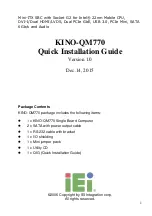
OLIMEX© 2015
A13-SOM user's manual
6.1.1 UART1 interface
The UART1 interface might be used for serial communication between the board and a personal
computer by default. In case of video output problem a cable might provide needed feedback and
greatly reduce the efforts needed to repair the board or to adjust the software setting.
Note that by default only UART1 is defined as a port suitable for serial debug. You can use our
USB-SERIAL-CABLE-F for debugging.
Even when A13-SOM is mounted on A13-SOM-WIFI the default debug port remains UART1
(despite that it gets additional pins on the big board also for easier access).
Consider table below when connecting the USB-SERIAL-CABLE-F according to the wire color
code. The RX line of the cable (GREEN wire) should go to TX line of the target board; the TX line
of the cable (RED wire) should go to the RX line of
the target board. The BLUE wire should go to the
target's GND line. Make sure to leave free the first
pin (named “3.3”) when connecting the serial cable.
The table of UART1 signals might be found below:
UART1
Pin # Signal name
Processor pin
1 3.3
VCC
2 UART1-TX
A7
3 UART1-RX
B7
4 GND
GND
6.2 MicroSD card connector
The micro SD card slot is primarily used for booting the operating system.
The board works with micro SDHC cards up to 32GB of storage.
As a general precaution be careful with the SD cards you purchase. There is a big percentage of
fake cards due to the low effort required to counterfeit popular brands and the big demand for SD
cards worldwide. When in doubt – try the same operation with another card from another brand.
Olimex sells microSD cards prepared with Linux or Android images, that have been tested – please
refer to chapter “2.2 Requirements”. Currently these are with either 4GB and 8GB of storage
(depending on the purchase date). Of course, if you already have a large enough microSD card you
can download the official Linux image from the wiki pages:
https://www.olimex.com/wiki/A13-
When removing the card, please make sure that you release it from the connector by pushing and
NOT by pulling the card directly (this can damage both the connector and the microSD card).
Page 24 of 36




























